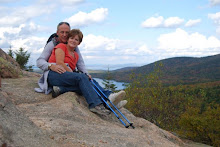
 Andy and I both slept great last night in our own bed. The best in the past 4 weeks. (Sorry Jennifer and Amanda). We got back into our little routine and realize how nice it is not to live out of a suitcase! Altho, it was much colder at night. Had the furnace on.
Andy and I both slept great last night in our own bed. The best in the past 4 weeks. (Sorry Jennifer and Amanda). We got back into our little routine and realize how nice it is not to live out of a suitcase! Altho, it was much colder at night. Had the furnace on.Eight miles south of Ocean City is Assateague Island National Seashore, paralleling the coast of Maryland and Virginia. It is a narrow 37-mile-long barrier island and home to the Chincoteague wild horses, locally called "ponies". During the summer, these ponies are seen on the beach where the sea breezes offer relief from the biting insects. Occasionally, they can be seen entering the surf to cool off, too. We were hoping to see them on the beach and searched for hours trying to find them. The park service had told us during the storm last week, the ponies were not even visible. We definitely saw "signs" of them all over the beach and trails!! Just as we were leaving the park, many were standing along the side of the road, stopping traffic. Some will eat right from your hands, as you can see the one ponie sticking his nose in that car! But they are wild and have unpredictable behavior. The cooler fall weather and fewer insects allow the herds to move from the beaches back to the marshes. They graze on abundant salt marsh cord grass, hay and beach grass. Unfortunately this diet is nutrient-poor, resulting in the short stature. They are slightly smaller than other horses and shaggy in appearance and have lived on Assateague Island for more then two hundred years. In 1968, there were 28 horses wild and free-roaming. Today there are 150 ponies, the number being controlled by contraception conducted by the National Park Service.





No comments:
Post a Comment